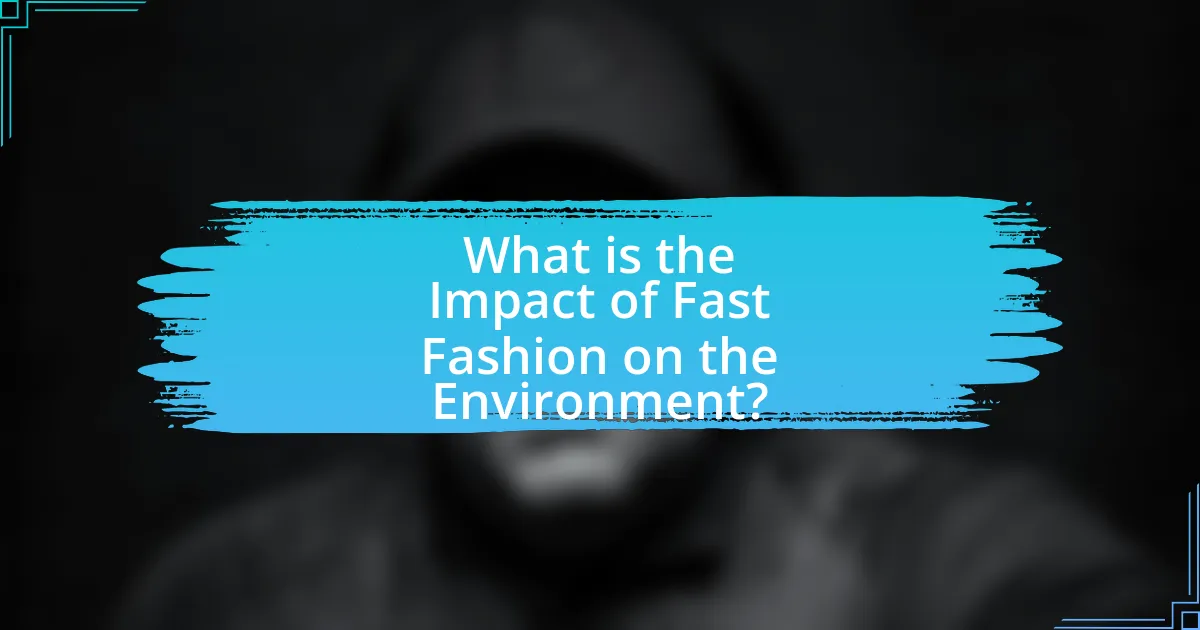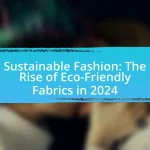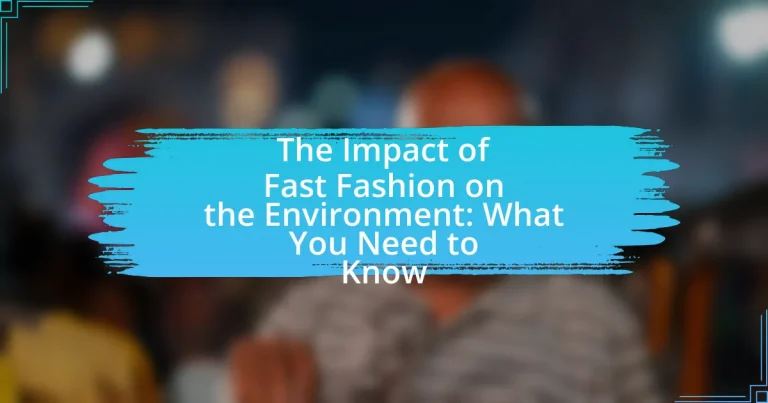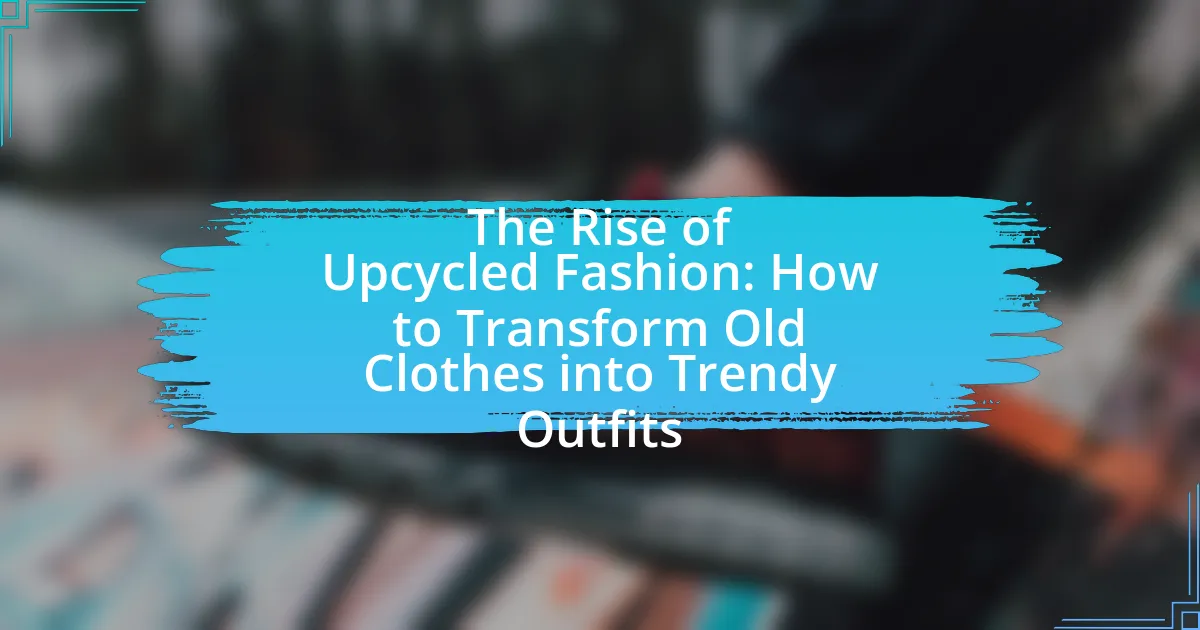The article examines the significant environmental impact of fast fashion, highlighting its role in excessive resource consumption, pollution, and waste generation. Fast fashion is responsible for approximately 10% of global carbon emissions and contributes to severe water pollution through toxic dyeing processes. The industry generates around 92 million tons of textile waste annually, exacerbating landfill overflow and greenhouse gas emissions. Additionally, the article discusses the depletion of natural resources, the influence of consumer behavior on fast fashion practices, and potential solutions to mitigate its environmental consequences, including sustainable materials and regulatory measures.

What is the Impact of Fast Fashion on the Environment?
Fast fashion significantly harms the environment through excessive resource consumption, pollution, and waste generation. The industry is responsible for approximately 10% of global carbon emissions, primarily due to the production processes that rely heavily on fossil fuels. Additionally, fast fashion contributes to water pollution, with textile dyeing releasing toxic chemicals into waterways, affecting aquatic ecosystems. The production of garments also leads to massive water usage, with an estimated 2,700 liters required to produce a single cotton t-shirt. Furthermore, fast fashion promotes a throwaway culture, resulting in millions of tons of textile waste ending up in landfills each year, where synthetic fibers can take hundreds of years to decompose.
How does fast fashion contribute to environmental degradation?
Fast fashion contributes to environmental degradation primarily through excessive resource consumption and pollution. The production of fast fashion garments requires vast amounts of water, with the fashion industry consuming approximately 93 billion cubic meters of water annually, which leads to water scarcity in many regions. Additionally, the use of synthetic fibers, such as polyester, results in microplastic pollution, as these materials shed tiny particles during washing, contaminating oceans and waterways. Furthermore, fast fashion generates significant textile waste, with an estimated 92 million tons of textiles discarded each year, contributing to landfill overflow and greenhouse gas emissions. The rapid production cycles and low-quality materials associated with fast fashion exacerbate these environmental issues, making it a major contributor to ecological harm.
What are the primary environmental issues caused by fast fashion?
The primary environmental issues caused by fast fashion include excessive water consumption, pollution from textile dyes, and significant textile waste. Fast fashion brands often use large quantities of water for production; for instance, producing a single cotton shirt can require up to 2,700 liters of water. Additionally, the dyeing process releases toxic chemicals into waterways, contributing to water pollution and harming aquatic ecosystems. Furthermore, fast fashion contributes to a massive amount of textile waste, with an estimated 92 million tons of textiles discarded globally each year, leading to increased landfill use and greenhouse gas emissions as these materials decompose.
How does fast fashion affect natural resources?
Fast fashion significantly depletes natural resources by promoting excessive consumption and rapid production cycles. The industry relies heavily on water, with the production of a single cotton t-shirt requiring approximately 2,700 liters of water, enough for one person to drink for two and a half years. Additionally, fast fashion contributes to deforestation, as forests are cleared for cotton farming and synthetic fiber production, which often involves petroleum extraction. The extraction and processing of these materials lead to habitat destruction and biodiversity loss. Furthermore, the fast fashion model encourages the use of non-renewable resources, resulting in increased carbon emissions and pollution, as synthetic fibers like polyester are derived from fossil fuels. These practices collectively strain the planet’s natural resources, leading to long-term environmental degradation.
Why is fast fashion a growing concern for sustainability?
Fast fashion is a growing concern for sustainability because it leads to excessive waste, resource depletion, and environmental degradation. The fast fashion industry produces around 92 million tons of textile waste annually, with a significant portion ending up in landfills. Additionally, the production processes consume vast amounts of water and energy; for instance, producing a single cotton t-shirt requires approximately 2,700 liters of water. This unsustainable model not only contributes to pollution but also exacerbates climate change, as the industry is responsible for about 10% of global carbon emissions.
What role does consumer behavior play in the fast fashion industry?
Consumer behavior significantly influences the fast fashion industry by driving demand for inexpensive, trendy clothing. This demand encourages brands to produce large quantities of garments quickly, often leading to unsustainable practices. For instance, a report by McKinsey & Company highlights that the average consumer buys 60% more items of clothing than they did 15 years ago, contributing to increased waste and environmental degradation. Additionally, consumers’ preference for low prices and rapid turnover of styles compels brands to prioritize speed over sustainability, resulting in a detrimental impact on the environment.
How does fast fashion influence waste generation?
Fast fashion significantly influences waste generation by promoting a cycle of rapid production and consumption that leads to increased textile waste. The industry produces approximately 92 million tons of textile waste annually, with a large portion ending up in landfills due to the low quality and short lifespan of fast fashion garments. Additionally, consumers are encouraged to buy more frequently and discard items quickly, exacerbating the waste problem. This trend is supported by the fact that the average consumer now buys 60% more clothing than in 2000, yet retains each item for half as long, contributing to a staggering increase in waste generation.

What are the Specific Environmental Consequences of Fast Fashion?
Fast fashion leads to significant environmental consequences, including excessive waste, high carbon emissions, and water pollution. The industry generates approximately 92 million tons of textile waste annually, with a large portion ending up in landfills. Additionally, fast fashion contributes to around 10% of global carbon emissions, primarily due to energy-intensive production processes. Water pollution is exacerbated by the use of toxic dyes and chemicals, which contaminate water sources, affecting ecosystems and human health. These facts illustrate the detrimental impact of fast fashion on the environment.
How does fast fashion impact water pollution?
Fast fashion significantly contributes to water pollution through the excessive use of water in textile production and the discharge of harmful chemicals into water bodies. The fashion industry is responsible for approximately 20% of global wastewater, primarily due to dyeing processes that utilize toxic substances like azo dyes, which can contaminate rivers and lakes. Additionally, the production of synthetic fibers, such as polyester, releases microplastics into waterways, further exacerbating pollution. Studies indicate that around 500,000 tons of microfibers are released into the ocean annually from washing synthetic garments, posing risks to marine life and ecosystems.
What chemicals are commonly used in fast fashion production?
Chemicals commonly used in fast fashion production include azo dyes, formaldehyde, and phthalates. Azo dyes are prevalent for their vibrant colors but can release carcinogenic compounds. Formaldehyde is often used in textile finishing to prevent wrinkles and mildew, posing health risks such as skin irritation and respiratory issues. Phthalates, utilized as plasticizers in synthetic fabrics, can disrupt endocrine functions. These chemicals contribute significantly to environmental pollution and health hazards associated with the fast fashion industry.
How do these chemicals affect aquatic ecosystems?
Chemicals from fast fashion, such as dyes and heavy metals, significantly harm aquatic ecosystems by contaminating water bodies and disrupting aquatic life. These pollutants can lead to decreased oxygen levels, harming fish and other organisms, and can cause bioaccumulation of toxic substances in the food chain, ultimately affecting biodiversity. For instance, a study published in the journal Environmental Science & Technology found that textile dyes can be lethal to aquatic organisms at low concentrations, demonstrating the direct impact of these chemicals on ecosystem health.
What is the carbon footprint of fast fashion?
The carbon footprint of fast fashion is estimated to be around 2.1 billion metric tons of CO2 equivalent annually, which accounts for approximately 10% of global greenhouse gas emissions. This significant impact arises from various stages of the fashion supply chain, including raw material extraction, manufacturing, transportation, and disposal. For instance, the production of a single cotton t-shirt can generate about 2.1 kg of CO2 emissions, while the overall fast fashion industry contributes more emissions than international flights and maritime shipping combined.
How does fast fashion contribute to greenhouse gas emissions?
Fast fashion contributes to greenhouse gas emissions primarily through the production processes, which involve high energy consumption and the use of fossil fuels. The fashion industry is responsible for approximately 10% of global carbon emissions, largely due to the manufacturing of synthetic fibers, extensive transportation, and the disposal of garments in landfills. For instance, the production of polyester, a common fabric in fast fashion, emits around 706 million tons of CO2 annually. Additionally, the rapid turnover of clothing leads to increased waste, as discarded items decompose and release methane, a potent greenhouse gas.
What are the long-term effects of these emissions on climate change?
The long-term effects of emissions from fast fashion on climate change include increased global temperatures, altered weather patterns, and rising sea levels. These emissions, primarily carbon dioxide and methane, contribute significantly to the greenhouse effect, which traps heat in the atmosphere. According to the Intergovernmental Panel on Climate Change (IPCC), human activities, including those from the fashion industry, have led to a 1.1°C increase in global temperatures since the late 19th century. This warming results in more frequent and severe weather events, such as hurricanes and droughts, and contributes to the melting of polar ice, which raises sea levels. The fashion industry is responsible for approximately 10% of global carbon emissions, underscoring its substantial impact on climate change.

What Solutions Exist to Mitigate the Environmental Impact of Fast Fashion?
Solutions to mitigate the environmental impact of fast fashion include promoting sustainable materials, implementing circular economy practices, and encouraging consumer awareness. Sustainable materials, such as organic cotton and recycled polyester, reduce resource consumption and pollution during production. Circular economy practices, like clothing recycling and resale, extend the lifecycle of garments and minimize waste. Additionally, consumer awareness campaigns can educate individuals about the environmental consequences of fast fashion, leading to more responsible purchasing decisions. According to a 2021 report by the Ellen MacArthur Foundation, transitioning to a circular fashion system could reduce global fashion emissions by 44% by 2030, highlighting the effectiveness of these solutions.
How can consumers make more sustainable fashion choices?
Consumers can make more sustainable fashion choices by prioritizing brands that use eco-friendly materials and ethical production practices. Research indicates that the fashion industry is responsible for 10% of global carbon emissions, highlighting the importance of selecting sustainable options. By choosing clothing made from organic cotton, recycled materials, or sustainable fabrics like Tencel, consumers can significantly reduce their environmental impact. Additionally, supporting brands that are transparent about their supply chains and labor practices fosters ethical consumption. Engaging in second-hand shopping and clothing swaps also extends the lifecycle of garments, further mitigating waste.
What are the benefits of choosing sustainable brands?
Choosing sustainable brands significantly reduces environmental impact by promoting eco-friendly practices. Sustainable brands often utilize materials that are biodegradable or recycled, which minimizes waste and pollution. For instance, a study by the Ellen MacArthur Foundation indicates that shifting to circular fashion could reduce greenhouse gas emissions by 44% by 2030. Additionally, these brands typically prioritize ethical labor practices, ensuring fair wages and safe working conditions, which contributes to social sustainability. By supporting sustainable brands, consumers help drive demand for responsible production methods, fostering a more sustainable economy overall.
How can recycling and upcycling reduce fast fashion’s impact?
Recycling and upcycling can significantly reduce fast fashion’s impact by minimizing waste and conserving resources. Recycling transforms discarded textiles into new materials, thereby reducing the demand for virgin resources and lowering greenhouse gas emissions associated with production. For instance, the Ellen MacArthur Foundation reports that recycling one ton of textiles can save approximately 20,000 liters of water and reduce carbon emissions by 3,000 kilograms. Upcycling, on the other hand, repurposes old garments into new products, extending their lifecycle and decreasing the volume of waste sent to landfills. This practice not only diverts waste but also promotes creativity and sustainable consumption. Together, these methods contribute to a circular economy, which is essential for mitigating the environmental consequences of fast fashion.
What role do regulations play in addressing fast fashion’s environmental issues?
Regulations play a crucial role in addressing fast fashion’s environmental issues by establishing legal frameworks that limit harmful practices and promote sustainable alternatives. For instance, regulations can enforce stricter waste management protocols, requiring brands to reduce textile waste and improve recycling processes. The European Union’s Circular Economy Action Plan aims to make sustainable products the norm, which directly impacts the fast fashion industry by mandating eco-design and resource efficiency. Additionally, regulations can impose penalties for non-compliance with environmental standards, incentivizing companies to adopt greener practices. Studies indicate that countries with stringent environmental regulations see a significant reduction in pollution levels associated with textile production, highlighting the effectiveness of regulatory measures in mitigating fast fashion’s environmental impact.
What policies can governments implement to promote sustainable fashion?
Governments can implement policies such as tax incentives for sustainable practices, regulations on waste management, and support for eco-friendly materials to promote sustainable fashion. Tax incentives can encourage brands to adopt sustainable practices by reducing their financial burden, as seen in countries like Sweden, where tax breaks for sustainable businesses have led to increased investment in eco-friendly technologies. Regulations on waste management can mandate recycling and responsible disposal of textile waste, similar to the Extended Producer Responsibility laws in the European Union, which hold manufacturers accountable for the lifecycle of their products. Additionally, supporting research and development of eco-friendly materials can foster innovation in sustainable textiles, as demonstrated by government grants in countries like the Netherlands aimed at developing biodegradable fabrics.
How can industry standards improve environmental practices in fashion?
Industry standards can significantly improve environmental practices in fashion by establishing benchmarks for sustainability that brands must adhere to. These standards, such as the Global Organic Textile Standard (GOTS) and the Sustainable Apparel Coalition’s Higg Index, provide clear guidelines on resource usage, waste management, and chemical safety. By complying with these standards, companies can reduce their carbon footprint, minimize water consumption, and ensure responsible sourcing of materials. For instance, a study by the Ellen MacArthur Foundation highlights that implementing circular economy principles, which are often part of industry standards, can lead to a 70% reduction in textile waste. Thus, industry standards not only promote accountability but also drive innovation towards more sustainable practices in the fashion sector.
What practical steps can individuals take to reduce their fast fashion consumption?
Individuals can reduce their fast fashion consumption by adopting several practical steps. First, they can prioritize buying high-quality, durable clothing that lasts longer, thereby decreasing the frequency of purchases. Second, individuals should consider shopping second-hand or vintage, which extends the life cycle of garments and reduces demand for new production. Third, they can implement a “one in, one out” policy, ensuring that for every new item purchased, an old item is donated or recycled. Additionally, individuals can support sustainable brands that prioritize ethical production practices and environmentally friendly materials. Lastly, they can educate themselves and others about the negative impacts of fast fashion, fostering a community that values sustainable choices. These actions collectively contribute to a significant reduction in fast fashion consumption and its environmental impact.
















